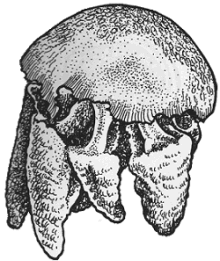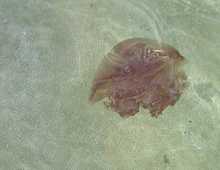 |
|

|
Discovery
12, I live in the sea: Sea jellies
courtesy
Great Barrier Reef Marine Park Authority
|
|
Jellyfish
are not fish, but are actually Cnidarians
or sea jellies. They are invertebrate
animals, which means they do not have
a backbone. Large adult sea jellies
are often accompanied by small fish
which hide amongst their tentacles
for protection.
All
sea jellies have stinging tentacles
but the stings vary from severe to
a mild and temporary prickling or
burning sensation. For humans, sea
jellies are among the most dangerous
animals in the sea. Box jelly and
irukandji are capable of inflicting
serious and even fatal stings.
Sea jellies are most recognised because
of their jelly like appearance and
this is where they get their name.
They are also recognised for their
bell-like shape and tentacles. Sea
jelly species vary in size, some reaching
two metres across the bell and trailing
tentacles 30 metres behind them. Some
have bodies that are so clear you
can see right through them.
Some
sea jelly have a thick fluffy-looking
frill between the upper bell and the
lower tentacles, which actually contain
countless mouths to trap small organisms
from surrounding waters. The upside-down
sea jelly betrays its close relationship
with the anemones by attaching itself,
tentacles up, to sandy and muddy bottoms,
often in the vicinity of mangroves.
Like so many other cnidarians, sea
jelly have zooxanthellae in their
tissue.
|

Drawing
courtesy Wet
Paper |
| |
|
|

Plastic
bag or sea jelly?
Marine species confuse plastic
bags, rubber,
balloons and confectionery wrappers
with food
and eat them. A plastic bag
looks like a sea jelly
to a turtle. Sea birds eat polystyrene
balls (like
fish eggs) and small bits of
plastic (like little fish)
then take them back to their
nest to regurgitate
them to feed the chicks.
|
Sea jelly drift at the mercy
of the currents, often accumulating
in sheltered bays and estuaries.
They swim in an unusual way
- a pumping action where muscles
in their bodies contract and
propel them through the water.
This does little more than allow
them to move up or down in the
water. However, the four sided
box jelly are powerful swimmers
with good control and speed.
Sea jelly reproduction is often
complex involving two different
body forms - the attached polyp
and the free-swimming sea jelly-like
medusa stage. Like most other
Cnidarians, sea jelly have a
two-part life-cycle. The first
stage is the familiar free-swimming
bell-like stage. The polyp is
the lessor known stage, which
forms just after egg and sperm
combine. The polyp stage is
normally very small and not
free-swimming. Prior to summer
the polyp starts to shed parts
of its body, each of which grow
to form the swimming sea jelly
stage.
The sea jelly is made
up of 95% water.
A group of jellies is
called a smack. |
|
|
|
Depending on the number and length
of tentacles, sea jelly feed in various
ways. Most catch their food with their
tentacles as it drifts by and is then
carried to the mouth, which is located
in the centre of the bell shaped body.
Some sea jelly eat small crustaceans
and fish, some eat minute planktonic
organisms.
Box
jelly (Chironex fleckeri)
Often called the sea wasp or marine
stinger, the box sea jelly is the
most dangerous marine animal to humans.
It inhabits the shallow coastal waters
around northern Australia and can
be found in the waters of the Great
Barrier Reef during the summer months
between October and April.
The
body or bell, which is box-like in
shape, can vary in size from 5-25
centimetres across and has groups
of tentacles (up to 15) at each of
the four corners. In an adult the
average length of tentacles is about
three metres. Box jellies move in
the water by filling their bell with
water and then forcing it out again
and they can travel at about two knots
(as fast as your normal walk). Their
tentacles, which are covered in millions
of stinging cells or nematocysts,
drag along behind them as they move.
The box jelly does not actively hunt
but relies on food to bump into it.
This is how humans are usually stung
when swimming or wading in the ocean.
The box jelly are difficult to see
as they are almost invisible in the
water. When an animal (or human) comes
into contact with the tentacles the
stinging cells are triggered and fine,
hollow threads pierce the victim allowing
the venom (poison) to enter. The tentacles
attach to the victim with the help
of a sticky material produced at the
same time.
Irukandji
(Carukia barnesi)
The irukandji sea jelly is also one
of the most dangerous marine animals
found in the Great Barrier Reef. The
irukandji is a tiny sea jelly with
a two centimetre wide bell and tentacles
from five to fifty centimetres long.
They are clear and extremely hard
to see in the water. An irukandji
sting can cause extreme sickness and
can even be fatal. Stings have been
recorded along various parts of the
Queensland coast within the Great
Barrier Reef Marine Park, including
in the Mackay/ Whitsunday region.
Swimming in the ocean between the
warmer months of October and May is
not recommended without protective
clothing such as a stinger suit. Care
should be taken when swimming in stinger
enclosures, as the irukandji is so
small it can sometimes fit.
|
|
|
|
|
|
